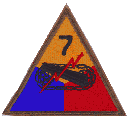

Recent News (November 2009): "After the Battle" magazine issue 145 (which came out in October 2009) had an excellent article ("The Liberation of Chartres ... and a Tank" by Jean-Paul Pallud that definitely ties the tank to Maj. Lohse at the time it was stopped in Chartres. This raises a number of questions, such as (1) whether Maj. Lohse had temporarily taken command of one of the D/31 light tanks (since the only tanks allocated to 31 Tank Bn were in D/31) for that specific mission or if he had been allocated one of the D/31 light tanks by Col. Erlenbusch on a continuing basis and (2) who all the men of the tank crew were.
On June 5, 2008, news media in France and around the world covered the story of the recovery of a tank of the 31st Tank Battalion (US 7th Armored Division) from where it had been buried for 64 years under the rue des Perriers in the southern part of Chartres, France. All sorts of hoopla and errors permeated these journalistic accounts. This web page is intended to give accurate information about this tank.
The presence of this tank showed that the penetration of one of the two forces of 7th Armored Division that attacked into Chartres on the night of 15-16 August 1944 penetrated in strength far more deeply into the city than had previously been realized. So this web page is also intended to give an understanding of that aspect of the battle.
Contents of this web page (which is very much under construction)
Here are links to some of the news media accounts.
Journalists do not usually make good historians. The job of a journalist is to take the events he or she is seeing in his or her immediate area and attempt to elevate them to being the most important thing that happened in the universe that day, so that their article and not someone else's will be printed or posted on the web. This journalistic fact of life does not lend itself to accuracy.
So here are corrections of some of the most glaring errors that appeared in the various news media accounts of the recovery of the buried tank.
For now, here is a very brief summary of the results of research in the 7th Armored Division records and also in Roger Joly's 1994 book La Libération de Chartres. There is still more to do in this, but the following seem well established.
Many things have prevented me from following up on this web page. However, Eric Santain sent the following in an e-mail on August 17, 2008. His thoughts are important and deserve to be here. I am not going to be able to follow up on this any time soon.
|
I am not agree with these idea in your site :
The tank was NOT the tank of Maj. Leslie Lohse. Maj. Lohse was the Operations Officer (S-3) of the 31st Tank Battalion. On the night of 15-16 August 1944, he was acting battalion commander and led Force #2 which attacked Luisant, in the southwest part of the Chartres metropolitan area. All of the tanks with Force #2 were medium tanks and not light tanks. In addition, the Germans stopped Force #2 west of the area where the buried tank was recovered. Major Lohse belonged to Staff of 31st Tank Bn and not to A B or Coys, so that he could take one of the M5 to the Staff or the Headquartet Coy. At the end of august 15, Force 2 had to cross the town West to East (Luce - Le Coudray). Major Lohse made a reconnaissance before the attack. Locals Testimonies said the crew of the M5 would arrived to the Church of Le Coudray. Lohse said too that he stayed with his men 3 days near a german staff. Force 1 with the D coy didn't take part to the attack and didn't lost any M5 that night. One platoon of the D coy made some pow's near Lèves but didn't cross the city of Chartres. |
Active overview of all pages at the 7th Armored Division web site